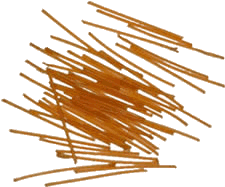- 01: Introduction
- 02: History
- 03: Propellants, Firearms, and Ammunition Development
- 04: Modern Firearms Manufacture
- 05: Small Arms Ammunition
- 06: Evidence Handling Procedures
- 07: Equipment and Instrumentation
- 08: Examination of Firearms
- 09: Cartridge and Shotshell Examination
- 10: Characterization and Evaluation of Fired Projectiles
- 11: Bullet Comparison and Identification
- 12: Gunshot Residue and Distance Determination
- 13: Toolmark Identification
- 14: Communicating Results
- Resources


Cordite
Home > Propellants, Firearms, and Ammunition Development > Evolution of Propellants > Modern Propellants > Cordite

Cordite rods
In a race to develop a smokeless powder, the British government commissioned a research group. Their solution was to mix acetone, nitrocellulose, nitroglycerin, and petroleum jelly to form a colloid. After evaporating the acetone solvent, the material could be extruded into long, cylindrical cords. In 1889, the resulting end product was named Cordite.
Vielle’s smokeless propellant, with nitrocellulose as the sole storehouse of energy, became known as single-base propellant. Nobel’s invention (which he named Ballistite) and the British Cordite, with their dual energy sources, became known as double-base propellants. Both single–base and double-base types are still in use today.
Smokeless propellants still retain the base ingredients used in the 1880s. However, knowledge of granule control, deterrent coatings, and safe processing has produced ammunition suitable for a wide range of uses from the smallest rimfire cartridges to massive naval guns.




